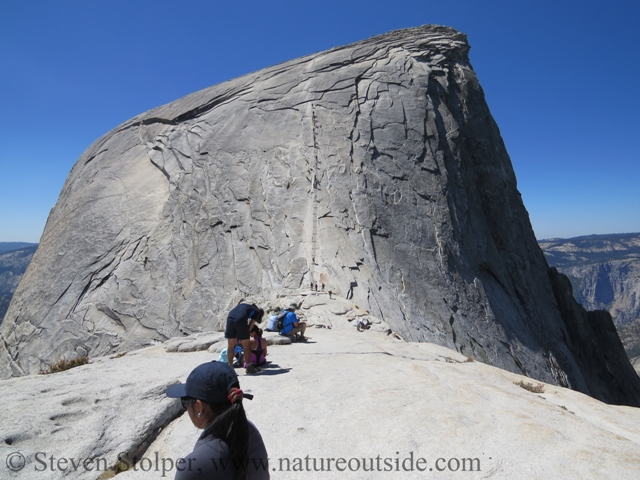
There are few features as iconic, or as beautiful, as Half Dome in Yosemite National Park. But it is not easy to get there. You won’t see a park bus with “Half Dome” written across the side. To reach the summit, you must hike to it from either Yosemite Valley or from Yosemite’s high country.
The day-hike from the valley floor to Half Dome is one of the most strenuous in Yosemite. The 16.4 mile (26.4 km) round trip climbs 4,839 feet from the valley floor to the summit. Your hike begins at an elevation of 4,000’ (1,220 m) and climaxes at 8,839’ (2,694 m). The combination of distance, elevation gain, and altitude make it a formidable hike.
But that’s not all! Just before the summit hikers see a shocking sight! From Sub Dome, which forms a “shoulder” with the summit, the trail ascends Half Dome’s sides at a hair-raising 45 degree angle. Two lines of cables line either side of the trail, anchored by poles in the granite. They provide meager assistance on the 400 foot climb. Make no mistake – a slip can be fatal. The last fatal fall from the cables occurred in 2011.
Half Dome, My Nemesis
Half Dome and I have history. In the early 2000s I trekked to Half Dome as a training hike for climbing Mt. Whitney. Being young and stupid, I decided to carry a full backpack instead of a light daypack. It was, after all, a “training hike.” Needless to say, by the time I reached the base of Sub Dome I was gassed.
At the base of Sub Dome, the sight that met my eyes froze me to the bones. For me, the hike to Half Dome holds a greater challenge than the distance, elevation gain, or altitude. You see, I have a problem with heights.
It is not that I fear high places. It is “exposure” I dread. Exposure is a technical term in rock climbing. It refers to the distance one has to fall before first contact with the ground. Another definition I have heard is, “It’s the amount of air under your rock shoes.”
The final push to Half Dome screams exposure. Add to this, we chose the Summer Solstice as the day for our training hike! It may be the most popular day of the year to scale Half Dome. Yosemite Park now requires permits to hike to Half Dome. This limits the number of Half Dome climbers to about 400 each day. Before the permit system more than 1,200 people shuffled up the cables daily.
So when I saw the “supermarket checkout line” on the exposed switchbacks of Sub Dome, I stopped. My tired legs would carry me no farther.
So Half Dome and I have unsettled business. It is the scene of a personal failure. After many years, my memory of that arduous hike and stopping short of my goal still stings.
The Right Quest at the Right Time
We should concern ourselves not so much with the pursuit of happiness, but more with the happiness of pursuit.
– Spoken by Christopher Plummer in the film, Hector and the Search for Happiness
A little adventure is good for the soul. It liberates us from the doldrums of our daily lives. The need to strive, test, reach, is fundamental to our being. Yet our modern society allows us to live our entire lives without ever exercising our potential.
A small quest that you set for yourself is your opportunity to grow as a person and broaden your horizons. It does not have to be grandiose! Your quest can be small, personal, and private. Its greatest reward can be self-discovery.
Hiking Half Dome again was my small quest. And the timing was not coincidental. I felt I needed the trip to distract me from my uncertain job situation. Such a trip forces one to focus, live in the moment, and stop dwelling on the future.
Awake before Dawn
I was in the park for three days. The first day, I acclimated to the altitude by hiking to Lembert Dome and Dog Lake. I spent the night camped at Hodgdon Meadow. This is a developed campground not far from the valley.
I chose that campground for a reason. There is an old adage in mountaineering, “Climb high, sleep low.” My Lembert Dome hike was at an altitude of approximately 8,775’ (2,675 m). Hodgdon Meadow is much lower, at 4,900’ (1,500 m). The theory is that oxygen intake decreases during sleep. So sleeping at a lower altitude reduces stress on the body.
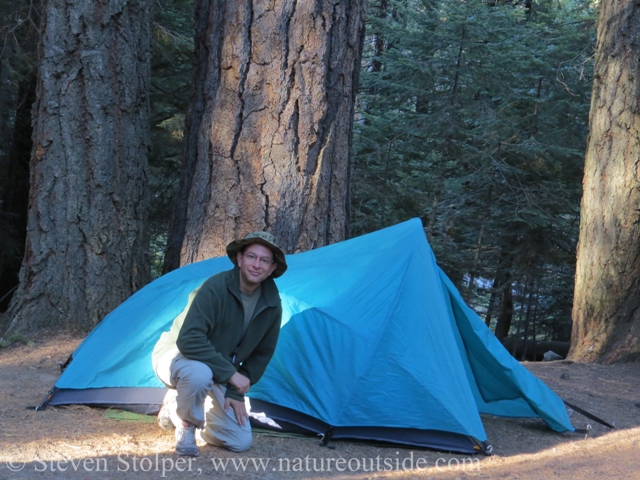
Camping at Hodgdon Meadow
I knew when I arrived at the park that I would be hiking Half Dome on my second day. I had entered the lottery for a permit to hike the Half Dome Cables 48 hours before my hike. You learn the evening you entered whether you secured a permit.
I awoke at 5:00 AM the day of my hike, anxious to be on the trail. My goal was to set out by 7:00 AM. Assuming a 2 mile-per-hour walking pace and an hour for lunch, I expected to be back by 4:00 PM. This gave me a healthy margin of daylight if I ran late.
By the time I parked at the trailhead it was closer to 8:00 AM. It was chilly and I could see my breath as I started up the Mist Trail. The Mist Trail wends its way beside the Merced River heading upstream along the floor of an enormous canyon. I enjoyed the play of light on the granite ramparts high above.
I reached my first decision point. It would be easier to hike the John Muir Trail to the top of Nevada Falls. This section of trail is used by mule trains that supply the distant Merced Lake High Sierra Camp. The trail continues onward for 210 miles to the summit of Mount Whitney. If I remained on the Mist Trail, I would have a steeper grade to climb. But I would see two spectacular waterfalls: Vernal Falls and Nevada Falls. I elected to stay on the Mist Trail. If I failed to reach Half Dome, the two waterfalls would be the highlight of my hike.
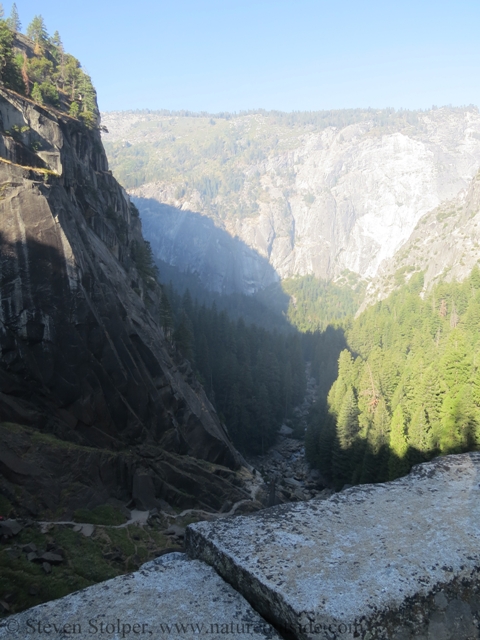
Top of Vernal Falls. You can see the trail climbing toward the falls on the left. It is usually shrouded in water and mist.
It was still early morning when I reached the top of 317-foot (97 m) Vernal Falls. I was astounded by how little water was flowing. It is our third year of drought in California. The river can flow as much as 10,000 cubic feet per second. It was probably doing less than a meager 5. I did not even bother to snap a picture.
On past hikes I have needed rain gear to pass the falls. Even in the low times, like now, I would get a light misting. Today I was able to remain completely dry.
Nevada Falls is one of my all-time favorites. It dominates the canyon at 594 feet (181 m) tall. As with Vernal, I was startled to see how little the water was flowing.
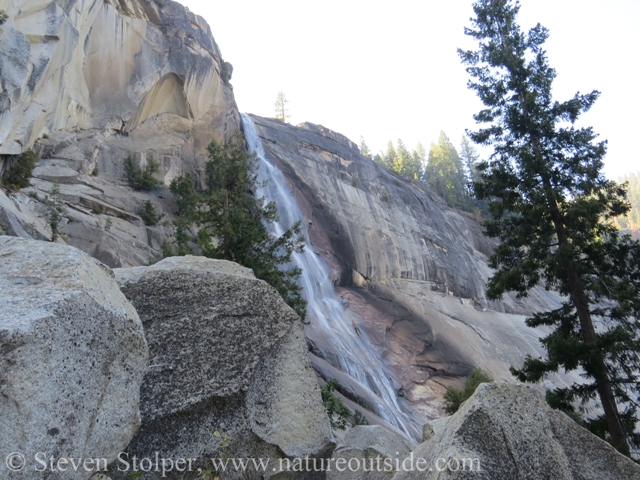
Nevada Falls seen from mid-way up the canyon wall. The black, water stained area shows where water normally flows when the falls are running high.
Up, Up and Away!
Above the falls, I walked through Little Yosemite Valley. The Merced River provided pleasant company. But all was not well. Physically I felt fine. But I was consuming water at twice the expected rate. I should still be alright, but I would finish the hike without a safe amount of extra water.
As I approached the base of Sub Dome, I started to labor. I did not feel particularly fatigued or winded. My body just wanted to rest for five minutes every 100 feet! Puzzled, I decided to stop for a snack and an extended rest. I must have craved the energy because I set out with renewed vigor.
My Sooty Grouse
I arrived at the base of Sub Dome and had lunch before beginning the final stages of the ascent. As I munched my beef jerky and cheese, I was startled to notice a large silhouette on the lower branches of a pine 15 feet above my head.
It was large, as big as a fully grown chicken! I grabbed my camera and crept forward for a better view.
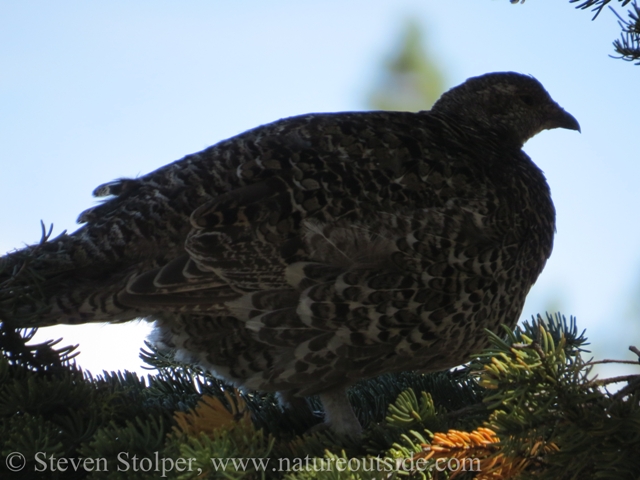
Is it a giant chicken?
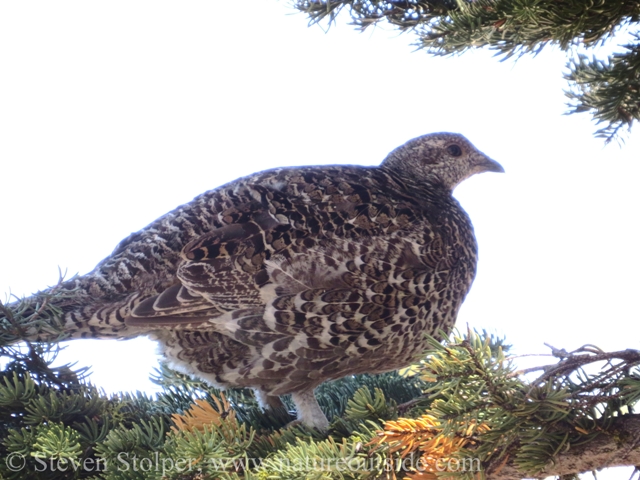
Sooty Grouse (Dendragapus fuliginosus). I think it is female.
It was the first time I had seen a Sooty Grouse (Dendragapus fuliginosus). The grouse are year-round residents of Yosemite. They blend perfectly with the lodgepole pine forest of the high country. From its coloration, I think this is a female.
The Sooty Grouse is the third largest grouse in North America, and one of the largest in the world. Most of the year they forage on the ground for leaves, flowers and conifer needles. In winter, they forage in trees for needles from pines and firs.
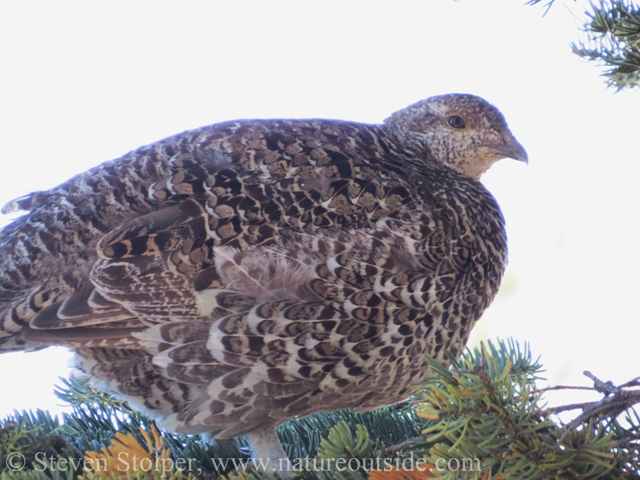
It is always exciting to see an unfamiliar animal.
They are usually solitary animals. Nesting season occurs May through June in Yosemite. During this time the males call to attract mates by inflating large neck sacs covered in yellow skin. The sacs act as resonators and project the birds’ calls for more than a quarter mile.
Sub Dome
Before you reach Half Dome, you must first conquer Sub Dome. The steep switchback resembles a staircase from a Harry Potter movie. The narrow path reverses every 30 feet with several large stone “steps” at each end. Alongside is nothing but air. The view is amazing! But several hikers became lightheaded by the feeling of great height.
I passed a married couple on the switchbacks. He had visited the summit twice before. But it was her first time. Both looked completely winded. He said he was fine going up but voiced concern about the trip down. As I felt my legs turning to jelly, I understood what he meant.
I left the couple behind and learned later that they had turned back before reaching the top of the switchbacks. The top of Sub Dome revealed a spectacular sight.

Half Dome in the distance with the cables ahead.
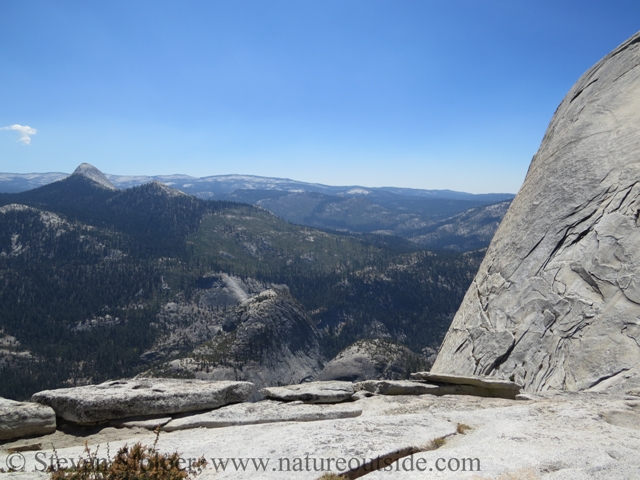
Looking around on Sub Dome
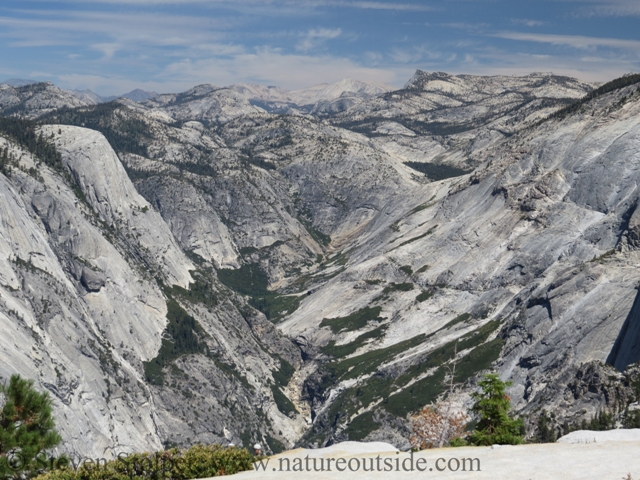
An ant’s view of the world!
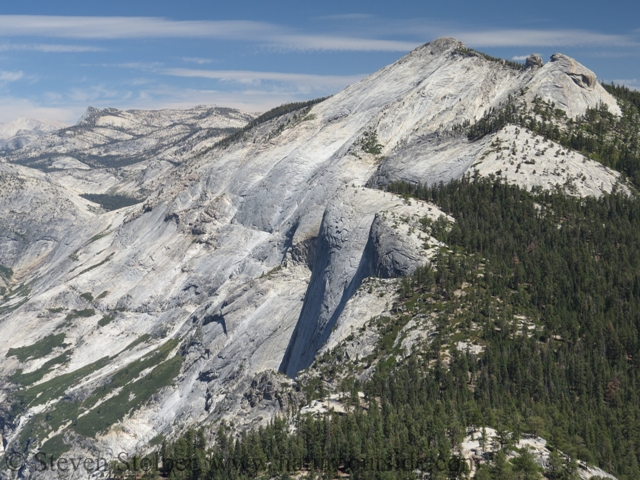
Giant granite ramparts
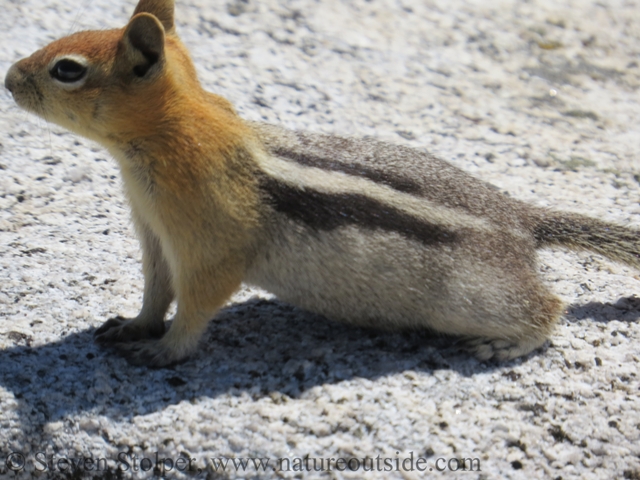
My cameraman is a Golden-mantled ground squirrel (Spermophilus lateralis).
They work for peanuts!
The Cables
In his 1870 guide book, prominent California geologist Josiah Whitney declared Half Dome1:
is… perfectly inaccessible, being probably the only one of all the prominent points about the Yosemite which never has been and never will be trodden by human foot
– Josiah D. Whitney
But in 1875, George Anderson pioneered a route to the top. He spent weeks drilling holes in the granite to anchor himself as he climbed. Today the current cables are very close to his original route.
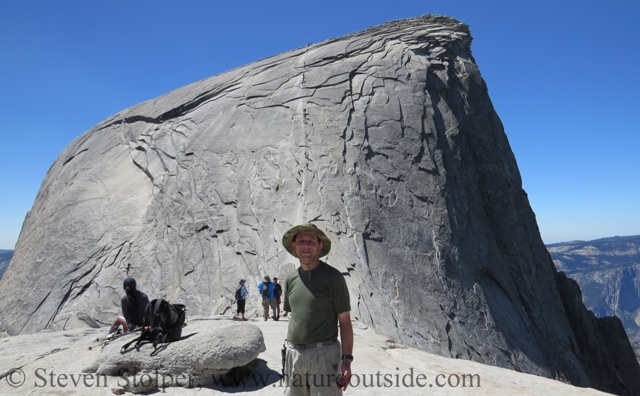
I told the squirrel to photograph me *and* the cables. Nuts!
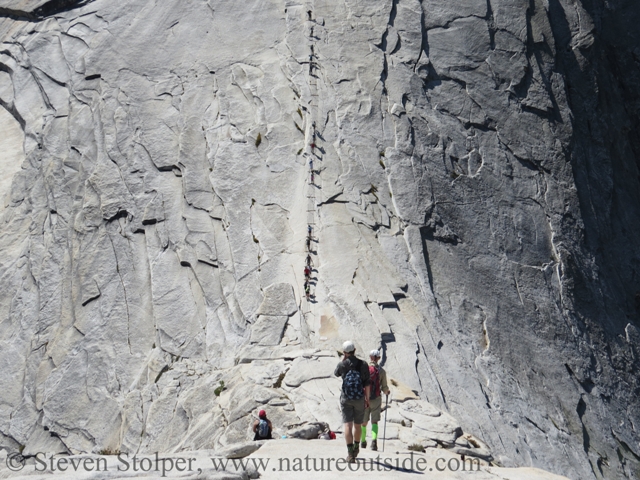
The approach to the base of the cables.
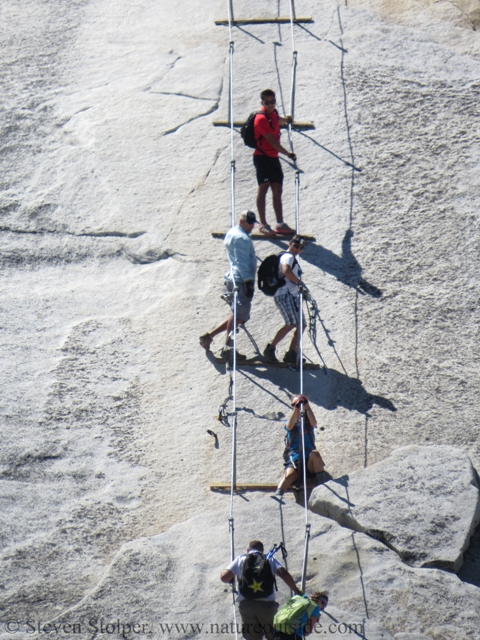
Resting on the way up.
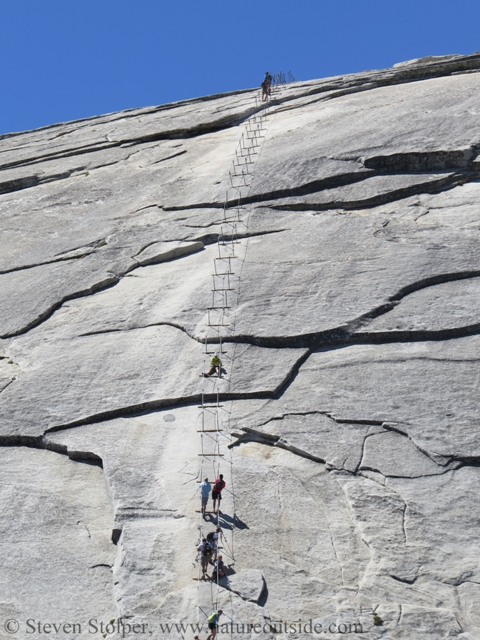
A better view of the incline.
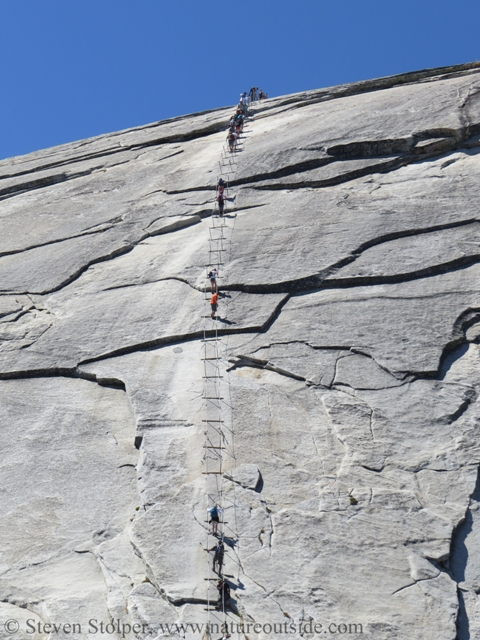
It is hard to convey the scale of the rock.
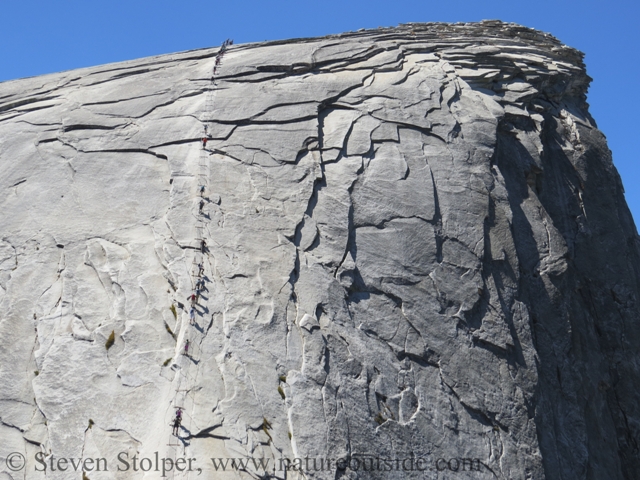
Like ants climbing a molehill
As I stepped toward the base of the cables my legs protested. I convened a quick vote among my body parts. I was in pretty good shape, but my legs obstinately declined to go any farther. It turned out that they had the most important votes. 🙂
So Sub Dome marked the end of my climb. Part of me was dissatisfied to hike this far and not attempt the cables. But it was the wise choice. My legs were not steady. I simply did not feel comfortable ascending the cables and then descending Half Dome and Sub Dome before hiking the remaining 8 miles to the trailhead.
But overall I felt good. The view was enthralling! And it felt terrific just being on Sub Dome. The bracing wind, the dizzying height, and the gargantuan scale of the terrain allowed no room for disappointment. It was simply too stupendous!
Epilogue
This hike taught me an important lesson. The journey *is* the destination. I set a goal, “hike to the top of Half Dome,” and failed to achieve it. But I enjoyed the journey so much that it didn’t bother me.
Life is not always like that. But bushcraft often is!
As long as we enjoy what we are doing, our happiness will never depend on arbitrary goals. I will always reflect fondly on my trip to Sub Dome. It was a stunning success! More importantly, it taught me that bushcraft is not about achieving goals. It’s about pursuing them! So going forward, I will make a special effort to concern myself with the “happiness of pursuit.”
References
- Yosemite National Park: A Natural History Guide to Yosemite and Its Trails with Map, Jeffery P. Schaffer, Wilderness Press, 1999.
- All About Birds – Sooty Grouse
- NPS Yosemite Blog – Sooty Grouse
If you enjoyed this trip, you may want to read others in the trips section.

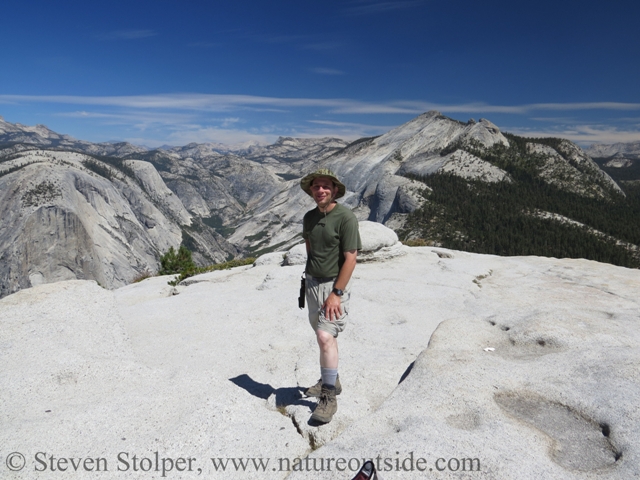


Just read your Half Dome adventure. It sounds awesome. Having only seen the dome from the valley I envy your experience. I don’t think I have the strength or stamina, never mind the tolerance for “exposure”, to attempt this but I do appreciate sharing the adventure through your eyes and descriptive words. The lesson learned is really what life is all about. Keep your journal coming.
Thanks, Gene! This experience helped me realize that there are adventures, large and small, available to all of us if we are open to them. Pursuing them is more important than achieving their goal.
The journey is the destination. If plan A fails use plan B keep available options open three is no regrets not reaching summits safety & well being take precedence. Many have died pushing for summits even in adverse conditions u may always return even beter prepared now knowing what others may not u made the right choice the memory is all ways there .climb on W.V.S.
I agree, Wesley, that safety always takes precedence. There is always the chance to return another day.
I commend you for your adventurist spirit.Just
taking that leap of faith is awesome!
Thank you, Phil!